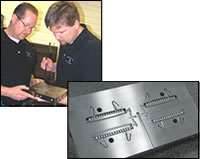Die/Mold
CAM Software Is The Driving Force
Doug Noxell knew he had the right software for machining to zero, so he created a shop to add the rest of the capability.
Read MoreHard Milling With Tandem Toolholding
A combination of toolholding choices lets this die shop get the most performance from its small-diameter tools.
Read MoreAn Overview Of 3+2 Machining
An introduction to 3+2 machining: how it works and what it can do for your machine shop.
Read MoreMainstream Technology Keeps Shop On Track
In its toolroom, Branchline Trains takes a practical approach to machining with end mills as small as 0.005 inch in diameter.
Read MoreThinking Big
This shop specifies large machine tools for the machining possibilities of the future. To prepare for the feed rates the shop expects to use one day, the latest large gantry mills apply linear motors on all three linear axes.
Read MoreStrategic Magnetic Workholding
Switching to a modular form of magnetic workholding enabled this global retread supplier to accommodate a greater number of parts in one setup while accelerating cycle times.
Read MorePractical Tips For High Speed Machining Of Dies And Molds
In die/mold work, the programmer can make the HSM process dramatically more effective. Here are some tips.
Read MoreMaking Programming Hands-Free (Almost)
Feature-recognition CAM software helps this technology company's internal mold shop deliver critical molds more quickly. A programmer is still needed, but the software automation saves considerable time.
Read MoreThe Hard Milling Imperative
Hard milling allows mold components to be machined in the hardened state, thus skipping several expensive and time-consuming processes such as electrical discharge machining and hand polishing.
Read MoreCAD/CAM Considerations For Micromilling
Milling with tools that are smaller than 100 microns in diameter presents equipment design and toolpath-generation challenges. This NC software maker offers strategies for creating safe, optimized tool paths for micromilling.
Read More




.jpg;maxWidth=300;quality=90)




